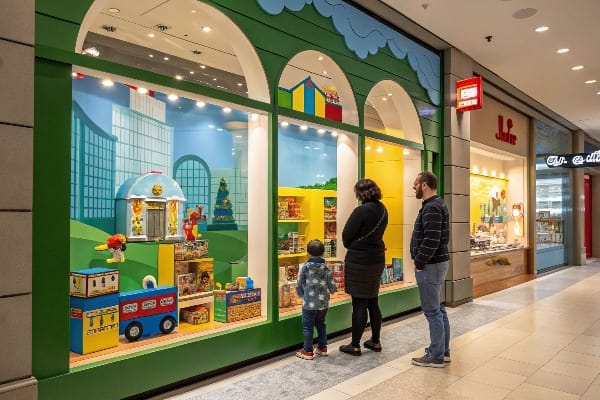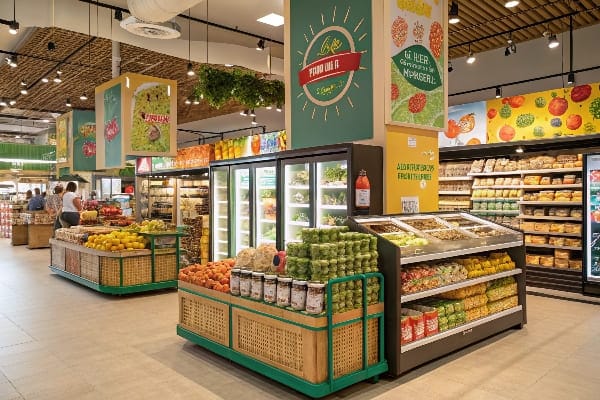许多零售商低估了定期更新其固定装置的重要性。当您无法刷新商店的外观时,客户可能会失去兴趣或没有注意到新产品。这通常会导致错过销售机会和商店流量下降。
定期更改零售固定装置可确保您的商店保持新鲜和吸引人的态度,为客户提供吸引人的氛围。您应该旨在每4至6周更新一次固定装置,以保持动态的购物体验。

动态的零售环境对于创造令人难忘的购物体验至关重要。现在,让我们探索一些有关零售固定装置的常见问题,以帮助您了解如何有效使用它们。
什么是零售的固定装置?
固定装置是任何零售商店中必不可少的组件。它们是以有条理且视觉上吸引人的方式展示产品的元素。固定装置包括架子,架子,桌子,人体模特和展示柜。它们旨在使产品脱颖而出,促进客户互动,并使他们更容易浏览。
零售的固定装置是用于显示和存储产品的任何结构,包括架子,机架和桌子。它们对于组织商店并改善购物体验至关重要。

零售中的固定装置的重要性
您显示产品的方式对客户行为有重大影响。有效的固定装置营造出诱人的氛围,并将购物者的注意力转移到关键物品上。例如,可调节的架子1可以容纳不同类型的产品,而人体模型可用于以栩栩如生的方式炫耀服装。零售固定装置也有助于商店的流程,从一个部分引导客户,而不会混淆。
除了改进布局外,固定装置还可以作为推广产品的工具。位置良好的桌子或展示架可以吸引客户进入新物品或特色物品。在某些商店中,固定装置还可以帮助按类别组织产品,从而使客户更容易找到所需的产品。
窗口显示多久更改一次?
窗口显示是吸引客户和营造紧迫感的强大工具。他们可以瞥见商店的产品,并可以在里面吸引路人。但是,保持窗口显示新鲜和相关是维持客户兴趣的关键。
窗口显示器至少应每两周更改一次。频繁的更新使显示器保持相关,并与当前趋势,促销或季节性事件保持一致。

为什么需要频繁更新
更改窗口显示2对于保持相关性至关重要。如果显示器保持不变的时间太长,它可能会陈旧,并且在吸引客户时失去了有效性。新鲜的窗户显示器还给您留下了这样的印象,即您的商店很活跃,并且与最新趋势保持一致。
季节性促销3或参与产品发布的零售商它们应该进行更新以反映这些变化,使它们与新的收藏或销售活动保持一致。此外,更改窗口显示可能是测试不同设置,设计和视觉策略4的,以查看最多客户吸引什么。
为什么零售商店布局很重要?
您商店的布局在客户满意度和销售中起着重要作用。良好的布局不仅可以增强购物体验,还会影响客户的支出。当客户可以轻松地浏览您的商店时,他们更有可能停留更长的时间并进行购买。
精心计划的零售商店布局至关重要,因为它会影响客户的购物体验并鼓励更长的访问,从而导致更高的销售额。

设计有效的布局
创建促进销售的商店布局5您应该考虑如何将产品分组和关键项目放置在何处。例如,高需求物品应放在后面附近,以鼓励客户在退房前充分探索商店。相反,脉冲项目6可以在结帐区附近放置,以鼓励自发购买。
有组织的商店布局也减少了摩擦。如果客户可以轻松找到他们想要的东西,他们将花费更少的时间搜索和更多的时间浏览。通往结帐区的明确途径可确保客户旅程7保持无缝和愉快。
超市中的固定装置是什么?
在超市,固定装置用于以一种使客户轻松找到和选择物品的方式来组织产品。其中包括架子,垃圾箱,冷却器和展示架,这些架子有助于存储和组织产品以方便访问。
在超市,固定装置是组织工具,例如货架,垃圾箱和冷却器,可让客户快速有效地找到产品。

超市固定装置的独特注意事项
与传统零售商店不同,超市需要专注于产品显示和可访问性。超市的固定装置通常是为了最大程度地提高空间并容纳大量物品的设计。例如, Gondola货架8被广泛用于展示杂货产品,可以轻松从双方访问。同样,冷藏式显示9和冰柜设备旨在使易腐烂的商品保持新鲜,同时为客户提供可见性。
此外,超市固定装置10通常会更新以与促销,季节性物品或新产品抵达保持一致。固定装置不仅应有效地展示产品,还应鼓励客户探索新的或打折的物品。
结论
定期更改零售固定装置,更新窗口显示并设计战略商店布局,这都有助于更好的客户体验和更高的销售。保持商店的新鲜和井井有条应该是保持竞争力的优先事项。
查找可调节货架如何最大化您的产品展示并改善商店中的客户参与度。 ↩
探索此链接,以了解窗口显示在吸引客户和增强商店吸引力方面的重要性。 ↩
发现有效的季节性促销策略,可以提高您的零售销售和客户参与度。 ↩
了解可以增强您的零售展示并吸引更多客户的成功视觉策略。 ↩
探索创建商店布局的有效策略,以最大化销售并增强客户体验。 ↩
了解策略性地放置冲动物品如何提高您的销售并鼓励自发购买。 ↩
发现有助于平稳客户旅程并提高整体满意度的基本组件。 ↩
探索此链接,以了解缆车架子在最大化超市产品可见性和可访问性方面的重要性。 ↩
了解冷藏显示器,以了解它们如何维护产品新鲜度,同时增强杂货店的客户体验。 ↩
发现超市灯具的最新趋势,以有效增强产品显示和客户参与度。 ↩

